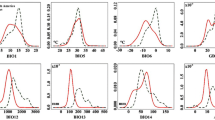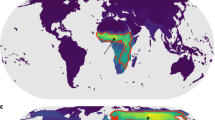Abstract
Ecological niche models are commonly used to identify regions at risk of species invasions. Relying on climate alone may limit a model’s success when additional variables contribute to invasion. While a climate-based model may predict the future spread of an invasive plant, we hypothesized that a model that combined climate with human influences would most successfully explain its present distribution. We used the ecological niche model MaxEnt to test our hypothesis with Japanese honeysuckle (Lonicera japonica), a common invasive horticultural plant in the United States. We first predicted the future range expansion of the species in the United States using a model that was trained on the climate conditions in its native range. We then tested the ability of a climate-based model, which was trained on climate conditions in the invaded range, to predict the current distribution in the United States. Finally, we tested whether including a measure of human influence would improve this model. Our results indicate that, despite L. japonica’s 200-year invasion history, it is expected to spread beyond its current US range. Climate and human influence combined explain the current distribution. Modeling the spread of invasive horticultural plants using climate alone risks under-predicting areas with poor climates and high human influence. Therefore, planting invasive horticultural species should be discouraged as even suboptimal climates may result in further range expansion.


Similar content being viewed by others
References
Chen P, Wiley EO, Mcnyset KM (2007) Ecological niche modeling as a predictive tool: silver and bighead carps in North America. Biol Invasions 9:43–51
Christen DC, Matlack GR (2009) The habitat and conduit functions of roads in the spread of three invasive plant species. Biol Invasions 11:453–465
Dehnen-Schmutz K, Touza J, Perrings C, Williamson M (2007) A century of the ornamental plant trade and its impact on invasion success. Divers Distrib 13:527–534
Dillenburg LR, Whigham DF, Teramura AH, Forseth IN (1993) Effects of below- and aboveground competition from the vines Lonicera japonica and Parthenocissus quinquefolia on the growth of the tree host Liquidambar styraciflua. Oecologia 93:48–54
Drake JM, Bossenbroek JM (2004) The potential distribution of zebra mussels in the United States. Bioscience 54:931–941
Drew J, Anderson N, Andow D (2010) Conundrums of a complex vector for invasive species control: a detailed examination of the horticultural industry. Biol Invasion 12:2837–2851
Dunlop EA, Wilson JC, Mackey AP (2006) The potential geographic distribution of the invasive weed Senna obtusifolia in Australia. Weed Res 46:404–413
Elith J, Phillips SJ, Hastie T, Dudík M, Chee YE, Yates CJ (2011) A statistical explanation for MaxEnt for ecologists. Divers Distrib 17:43–57
Ficetola GF, Thuiller W, Miaud C (2007) Prediction and validation of the potential global distribution of a problematic alien invasive species—the American bullfrog. Divers Distrib 13:476–485
Ficetola GF, Thuiller W, Padoa-Schioppa E (2009) From introduction to the establishment of alien species: bioclimatic differences between presence and reproduction localities in the slider turtle. Divers Distrib 15:108–116
Guisan A, Thuiller W (2005) Predicting species distribution: offering more than simple habitat models. Ecol Lett 8:993–1009
Hardt RA (1986) Japanese honeysuckle: from “one of the best” to ruthless pest. Arnoldia 46:27–34
Hernandez PA, Graham CH, Master LL, Albert DL (2006) The effect of sample size and species characteristics on performance of different species distribution modeling methods. Ecography 29:773–785
Hijmans RJ, Cameron SE, Parra JL, Jones PG, Jarvis A (2005) Very high resolution interpolated climate surfaces for global land areas. Int J Climatol 25:1965–1978
Kadoya T, Ishii HS, Kikuchi R, Suda S, Washitani I (2009) Using monitoring data gathered by volunteers to predict the potential distribution of the invasive alien bumblebee Bombus terrestris. Biol Conserv 142:1011–1017
Kilkenny FF (2011) Gene flow and adaptation in Lonicera japonica. PhD dissertation, University of Virginia, Charlottesville, VA, USA
Leatherman AD (1955) Ecological life-history of Lonicera japonica Thunb. Dissertation, University of Tennessee, Knoxville, TN, USA
Lemke D, Hulme PE, Brown JA, Tadesse W (2011) Distribution modeling of Japanese honeysuckle (Lonicera japonica) invasion in the Cumberland Plateau and Mountain Region, USA. Forest Ecol Manag 262:139–149
Leprieur F, Beauchard O, Blanchet S, Oberdorff T, Brosse S (2008) Fish invasions in the world’s river systems: when natural processes are blurred by human activities. PLoS Biol 6:404–410
Lockwood JL, Cassey P, Blackburn T (2005) The role of propagule pressure in explaining species invasions. Trends Ecol Evol 20:223–228
Lodge DM (1993a) Biological invasions: lessons for ecology. Trends Ecol Evol 8:133–137
Lodge DM (1993b) Species invasions and deletions: community effects and responses to climate and habitat change. In: Karieva PM, Kingsolver JG, Huey RB (eds) Biotic interactions and global change. Sinauer Associates, Sunderland, pp 367–387
McKinney ML (2001) Effects of human population, area, and time on non-native plant and fish diversity in the United States. Biol Conserv 100:243–252
Minton MS, Mack RN (2010) Naturalization of plant populations: the role of cultivation and population size and density. Oecologia 164:399–409
Nuzzo V (1997) Element stewardship abstract for Lonicera japonica. The Nature Conservancy, Arlington
Pattison RR, Mack RN (2008) Potential distribution of the invasive tree Triadica sebifera (Euphorbiaceae) in the United States: evaluating CLIMEX predictions with field trials. Glob Change Biol 14:813–826
Pemberton RW, Liu H (2009) Marketing time predicts naturalization of horticultural plants. Ecology 90:69–80
Peterson AT, Robins CR (2003) Using ecological-niche modeling to predict barred owl invasions with implications for spotted owl conservation. Conserv Biol 17:1161–1165
Peterson AT, Papes M, Kluza DA (2003) Predicting the potential invasive distributions of four alien plant species in North America. Weed Sci 51:863–868
Phillips SJ (2008) Transferability, sample selection bias and background data in presence-only modelling: a response to Peterson et al. (2007). Ecography 31:272–278
Phillips SJ (2010) A brief tutorial on MaxEnt. Lesson Conserv 3:107–135
Phillips SJ, Anderson RP, Schapire RE (2006) Maximum entropy modeling of species geographic distributions. Ecol Model 190:231–259
Pyšek P, Jarošík V, Hulme PE, Kühn I, Wild J, Arianoutsou M, Bacher S et al (2010) Disentangling the role of environmental and human pressures on biological invasions across Europe. Proc Natl Acad Sci USA 107:12157–12162
Reichard SH, White P (2001) Horticulture as a pathway of invasive plant introductions in the United States. Bioscience 51:103–133
Richardson DM, Iponga DM, Roura-Pascual N, Krug RM, Milton SJ, Hughes GO et al (2010) Accommodating scenarios of climate change and management in modeling the distribution of the invasive tree Schinus molle in South Africa. Ecography 33:1–13
Roura-Pascual N, Hui C, Ikeda T, Leday G, Richardson DM, Carpintero S, Espadaler X et al (2011) Relative roles of climatic suitability and anthropogenic influence in determining the pattern of spread in a global invader. Proc Natl Acad Sci USA 108:220–225
Sanderson EW, Jaiteh M, Levy MA, Redford KH, Wannebo AV, Woolmer G (2002) The human footprint and the last of the wild. Bio Sci 52:891–904
Schierenbeck K (2004) Japanese honeysuckle (Lonicera japonica) as an invasive species; history, ecology, and context. Crit Rev Plant Sci 23:391–400
Skulman BW, Mattice JD, Cain MD, Gbur EE (2004) Evidence for allelopathic interference of Japanese honeysuckle (Lonicera japonica) to loblolly and shortleaf pine regeneration. Weed Sci 52:433–439
Suarez AV, Tsutsui ND (2008) The evolutionary consequences of biological invasions. Mol Ecol 17:351–360
Sullivan JJ, Williams PA, Cameron EK, Timmons SM (2004) People and time explain the distribution of naturalized plants in New Zealand. Weed Technol 18:1330–1333
Thuiller W, Richardson DM, Rouget M, Procheş Ş, Wilson JRU (2006) Interactions between environment, species traits, and human uses describe patterns of plant invasions. Ecology 87:1755–1769
Urban MC, Phillips BL, Skelly DK, Shine R (2007) The cane toad’s (Chaunus [Bufo] marinus) increasing ability to invade Australia is revealed by a dynamically updated range model. Proc R Soc B 274:1413–1419
USDA (2009) Natural resources conservation service plants profile, Lonicera japonica thunb. [WWW document] URL http://plants.usda.gov/java/profile?symbol=LOJA
Wang R, Wang Y (2006) Invasion dynamics and potential spread of the invasive alien plant species Ageratina adenophora (Asteraceae) in China. Divers Distrib 12:397–408
Ward DF (2007) Modelling the potential geographic distribution of invasive ant species in New Zealand. Biol Invasion 9:723–735
Acknowledgments
We thank S. R. Keller for initial guidance on the use of MaxEnt. We also thank D. C. Gist of the University of Virginia’s Scholars’ Lab for significant assistance with ArcGIS. This manuscript was greatly improved through suggestions from J. Elith and two anonymous reviewers. We also thank D. A. Roach, M. L. Aikens, C. Dai, and K. Barnard-Kubow for offering valuable feedback on our manuscript. We thank the following herbaria for information on Lonicera japonica presence in the United States: TAMU, MNA, CMML, TAES, TAC, KANU, COLO, GH, NY, MO, LSU, MUR, BH, VPI, US. Finally, we thank the Jeffress Memorial Trust and the Jefferson Scholars Foundation for financial support.
Author information
Authors and Affiliations
Corresponding author
Electronic supplementary material
Below is the link to the electronic supplementary material.
Rights and permissions
About this article
Cite this article
Beans, C.M., Kilkenny, F.F. & Galloway, L.F. Climate suitability and human influences combined explain the range expansion of an invasive horticultural plant. Biol Invasions 14, 2067–2078 (2012). https://doi.org/10.1007/s10530-012-0214-0
Received:
Accepted:
Published:
Issue Date:
DOI: https://doi.org/10.1007/s10530-012-0214-0




